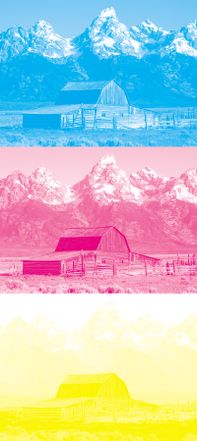النموذج اللوني سيان قرمزي أصفر أسود
النموذج اللوني س ق ص د إنگليزية: CMYK color model هو نموذج لوني طرحي يستخدم في الطباعة الملونة، كما يستخدم في وصف عملية الطباعة نفسها. تشير س ق ص د إلى الأحبار المستخدمة في معظم الطباعات الملونة: س/C السيان، وق/M القرمزي، وص/Y الأصفر، ود/K الأسود.
يرمز حرف K في الإنكليزية إلى كلمة Key حيث تعاير (Keyed) صفائح السحب (printing plates) في الطباعة رباعية الألوان مع صفيحة المفتاح (key plate). بعض المصادر تقترح أن K في CMYK أتت من آخر حرف من الأسود "black" حيث اختير هذا الحرف بدلا من B لأنه محجوز للدلالة على الأزرق[1][2]. هذا التوضيح على أية حال، وإن كان يخدم ظاهريا التذكر، إلا أنه غير صحيح[3].
يعمل النموذج اللوني س ق ص د بإقصاء بعض الألوان جزئيا أو كلياً على خلفية بيضاء (بامتصاص بعض أطوال الموجات الضوئية). يوصف هذا النموذج بأنه طرحي لأن الأحبار تطرح بعض السطوع من اللون الأبيض.
في النماذج اللونية الجمعية مثل النموذج اللوني ح خ ز أو RGB، يكون اللون الأبيض هو مجموع جميع الأضواء الملونة الأولية، في حين أن الأسود هو غياب الضوء. في النموذج اللوني س ق ص د تكون الأمور معكوسة، فالأبيض هو اللون الطبيعي للورقة أو السطح المطبوع عليه، والأسود هو نتيجة لتراكب الأحبار الملونة فوق بعضها البعض. ومن توفير النقود في الأحبار، ومن أجل الحصول على لون أسود داكن جدا، يستخدم حبر أسود بدلا من تراكب السيان والقرمزي والأصفر.
. . . . . . . . . . . . . . . . . . . . . . . . . . . . . . . . . . . . . . . . . . . . . . . . . . . . . . . . . . . . . . . . . . . . . . . . . . . . . . . . . . . . . . . . . . . . . . . . . . . . . . . . . . . . . . . . . . . . . . . . . . . . . . . . . . . . . . . . . . . . . . . . . . . . . . . . . . . . . . . . . . . . . . . .
Halftoning

زاوية الشاشة
To improve print quality and reduce moiré patterns, the screen for each color is set at a different angle. While the angles depend on how many colors are used and the preference of the press operator, typical CMYK process printing uses any of the following screen angles:[4][5]
| C | 15° | 15° | 105° | 165° |
|---|---|---|---|---|
| M | 75° | 45° | 75° | 45° |
| Y | 0° | 0° | 90° | 90° |
| K | 45° | 75° | 15° | 105° |
مزايا استخدام الحبر الأسود

التحويل
Since RGB and CMYK spaces are both device-dependent spaces, there is no simple or general conversion formula that converts between them. Conversions are generally done through color management systems, using color profiles that describe the spaces being converted. Nevertheless, the conversions cannot be exact, particularly where these spaces have different gamuts.
طالع أيضاً
- Hexachrome
- Spot color
- CcMmYK color model
- Grey component replacement
- Under color removal
- Under color addition
- Rich black
- Jacob Christoph Le Blon
- SWOP CMYK standard
- RGBY
المراجع
- ^ Horvat, Les (2003). Digital Imaging: Essential Skills. Focal Press. p. 74. ISBN 0240519132, 9780240519135.
{{cite book}}: Check|isbn=value: invalid character (help) - ^ Jennings, Simon (2003). Artist's Color Manual: The Complete Guide to Working with Color. Chronicle Books LLC. p. 21. ISBN 081184143X, 9780811841436.
{{cite book}}: Check|isbn=value: invalid character (help) - ^ Gatter, Mark (2004). Getting It Right in Print: Digital Pre-press for Graphic Designers. Laurence King Publishing. p. 31. ISBN 1856694216, 9781856694216.
{{cite book}}: Check|isbn=value: invalid character (help) - ^ Campbell, Alastair. The Designer's Lexicon. 2000 Chronicle, San Francisco. p 192
- ^ McCue, Claudia. Real World Print Production. 2007 Peachpit, Berkeley. p 31.
وصلات خارجية
- XCmyk—CMYK to RGB Calculator with source code
- Color Space Fundamentals—animated illustration of RGB vs. CMYK
- Color Separation Process—animation and activity
- Four Colour Process (CMYK) explained—basic explanation for novice print-buyers, including animated demonstration






